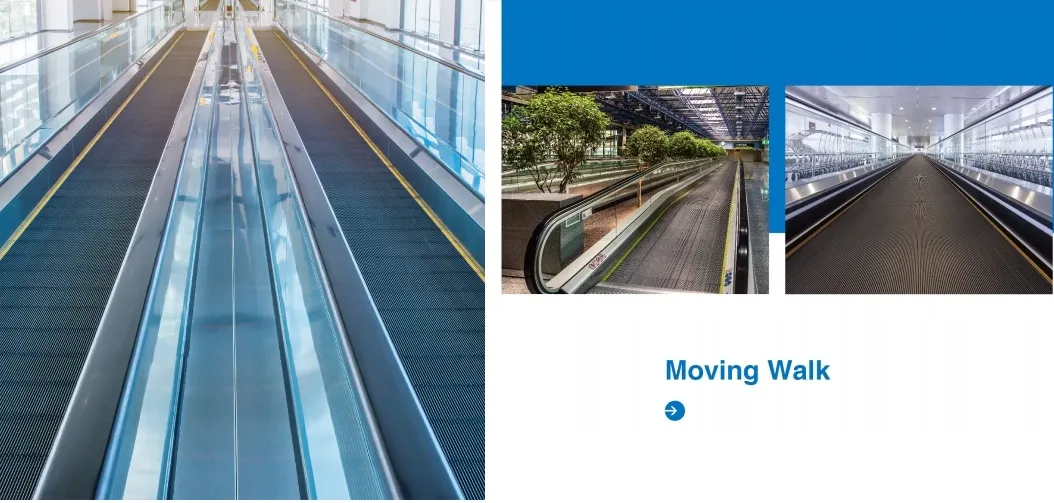
How do the horizontal length and speed of moving walkways meet the needs of different scenarios?

Picture yourself rushing through a bustling airport terminal - your flight boards in 15 minutes, and you're still miles from the gate. Suddenly, you step onto a moving walkway and feel instant relief as it propels you forward while you catch your breath. This everyday magic isn't random engineering; it's carefully calibrated design serving specific human needs.
The anatomy of movement
Moving walkways aren't just "flat escalators" as many assume. Their design balances three core elements: horizontal length determines how much distance they can cover seamlessly, belt speed dictates how quickly travelers move, and incline angles (when present) affect both accessibility and energy consumption. Getting these variables right creates those "ahh" moments when weary travelers suddenly gain momentum.
Airport accelerators
In airports like Dubai International or Atlanta's Hartsfield-Jackson, you'll find the longest walkways spanning over 300 feet. Why so long? Terminal designers know exhaustion breeds frustration. These extended runways maintain speeds around 1.5 mph - fast enough to cut transfer times by 40%, slow enough to prevent falls with luggage. The genius lies in the pacing: enough momentum to relieve tired legs without throwing off balance during that awkward suitcase shuffle.
Mall meanders
Contrast this with shopping centers like Mall of America, where walkways rarely exceed 100 feet. Here, the pace drops to 0.8-1 mph - what engineers call the "stroll boost." This subtle nudge compensates for shopping fatigue while keeping browsing comfortable. Retail psychologists confirm that slower speeds encourage peripheral vision engagement with stores, while discreet inclines of 3-6 degrees gently guide shoppers toward dining areas or attractions. It's traffic engineering disguised as convenience.
Specialized commercial flooring systems (as seen in premium installations) provide the necessary traction and durability. These surfaces maintain grip whether facing high heels in Tokyo's Ginza district or snow boots in Toronto's PATH network, demonstrating how infrastructure adapts to environmental demands.
Medical mobility
Hospitals reveal perhaps the most thoughtful implementations. At the Mayo Clinic, you'll find extra-wide walkways moving at just 0.5 mph with zero incline. This "recovery pace" accommodates IV poles and walkers while reducing patient exertion between appointments. The shorter 60-foot segments include frequent seating zones - acknowledging that for chemotherapy patients, even assisted movement requires breaks.
| Environment | Typical Length | Speed Range | Special Features |
|---|---|---|---|
| Major Airports | 250-350 ft | 1.4-1.8 mph | Acceleration zones before inclines |
| Shopping Centers | 80-120 ft | 0.7-1.1 mph | Decorative handrails, low glare lighting |
| Hospitals | 40-70 ft | 0.4-0.6 mph | Non-reflective surfaces, extra handholds |
Transit hub transformation: London's Waterloo Station
When engineers upgraded London's Waterloo Station, they faced conflicting needs: commuters demanded faster connections while tourists needed orientation time. The solution? Three-tiered walkways:
- Express lanes : 1.8 mph straight shots to platforms
- Transition zones : 1.0 mph sections with wayfinding displays
- Observation decks : Static areas with panoramic views
This "speed zoning" reduced peak-hour congestion by 28% by intuitively matching pace to purpose.
What's coming around the bend?
Tomorrow's innovations focus on responsive movement. Prototypes in Singapore's Changi Airport feature:
- Pressure-sensitive belts that accelerate during low-traffic periods
- Dynamic length extensions triggered by flight delays
- Integrated commercial flooring systems with LED path lighting that adjusts to walking speeds
As urban designer Marco Santos notes: "The magic happens when the technology disappears - when tired travelers feel helped rather than hustled, when frantic commuters gain time without realizing they're being engineered."
Whether shaving minutes off an airport transfer or gently easing hospital visits, moving walkways represent transportation psychology in action. Their unseen brilliance lies not in moving people, but in moving people well - matching mechanical parameters to human needs one thoughtful rotation at a time. Next time you step onto that familiar rubber belt, notice how its rhythm matches your purpose in that moment. That's no accident; it's thousands of hours of observation translated into motion you can feel in your bones.
Tags:
Recommend Products











